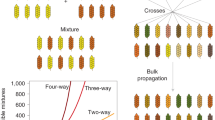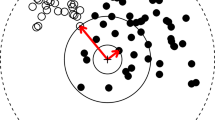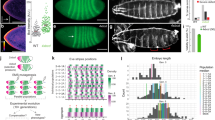Abstract
A logistic model of the competition diallel is presented based on two linear parameters for the exploitation component of competition, namely the acquisition rate (f) and utilization efficiency (u), and one linear parameter for the interference component of competition (i). This interference component encompasses all phenomena that are uniquely related to duocultures, such as resource partitioning, mutual stimulation, inhibition and complementation. The model uses yield-density regression coefficients (c-values), but could be adapted to suit other variates that account for both competitor density and relative frequency. In Drosophila larval competition most interference is negative and depresses the performance of duocultures with respect to monocultures, over and above that expected from shared exploitation of a common resource. Even in the closely controlled competitive conditions of these experiments this interference accounts for a considerable proportion of the total variation. The isolation of a general, and therefore predictable, interference component may prove useful in agriculture when assessing the relative importance of mixture effects to the yield potential of different crops.
Similar content being viewed by others
Article PDF
References
Altapov, W W. 1929. Growth and variation of the larvae of Drosophila melanogaster. J Exp Zool, 52, 407–432.
Baan-Hofman, T, and Ennik, G C. 1982. The effect of rootmass of perennial ryegrass (Lolium perenne L.) on the competitive ability with respect to couchgrass (Elytrigia repens (L.) Desv.). Neth J Agric Sci, 30, 275–283.
Barker, K. 1961. An analysis of factors which determine success in competition for food among larvae of Drosophila melanogaster. Neth J Zool, 19, 541–595.
Benjamin, L R. 1988. A single equation to quantify the hierarchy in plant size induced by competition within monocultures. Ann Bot, 62, 199–214.
Van Den Bergh, J P. 1968. An analysis of yields of grasses in mixed and pure stands. Versl Landb Onderz, 714, 1–71.
Birch, L C. 1957. The meanings of competition. Am Nat, 91, 5–18.
Breese, E L, and Hill, J. 1973. Regression analysis of interactions between competing species. Heredity, 31, 181–200.
Budnik, M, and Brncic, D. 1975. Effects of larval biotic residues on viability in four species of Drosophila. Evolution, 29, 777–780.
Burnet, B, Sewell, D, and Bos, M. 1977. Genetic analysis of larval feeding behaviour in Drosophila melanogaster. II. Growth relations and competition between selected lines. Gen Res Camb, 30, 149–161.
Cannell, M G R, Rothery, P, and Ford, E D. 1984. Competition within stands of Picea sitchensis and Pinus contorta. Ann Bot, 53, 349–362.
Chowdury, A R, and Hodgson, D R. 1982. Growth and yield in pure and mixed crops of potato cultivars. /. Agric Sci Camb, 98, 505–516.
Davtes, O L. 1957. Statistical Methods in Research and Production. Oliver and Boyd, Edinburgh.
Dawood, M, and Strickberger, M. 1964. The effect of larval interaction on viability in Drosophila melanogaster. Genetics, 50, 999–1007.
Eggleston, P. 1985. Variation for aggression and response in the competitive interactions of Drosophila melanogaster. Heredity, 54, 43–51.
Ford, E D, and Diggle, P J. 1981. Competition for light modelled as a spatially stochastic process. Ann Bot, 48, 481–500.
Godoy-Herrera, R. 1977. Intra- and interpopulational variation in digging in Drosophila melanogaster larvae. Behavl Gen, 8, 475–479.
Harper, J L. 1967. A Darwinian approach to plant ecology. J Ecol, 55, 247–270.
Hemmat, M, and Eggleston, P. 1988a. Competitive interactions in Drosophila melanogaster. recurrent selection for aggression and response. Heredity, 60, 129–137.
Hemmat, M, and Eggleston, P. 1988b. Competitive interactions in Drosophila melanogaster. genetic variation for interference media conditioning. Heredity, 61, 347–354.
Hill, J. 1990. The three C'S - competition, coexistence and coevolution — and their impact on the breeding of forage crop mixtures. Theor Appl Gen, 79, 168–176.
Johnson, I R, Parsons, A J, and Ludlow, M M. (1989). Modelling photosynthesis in monocultures and duocultures. Aus J PI Phys, 16, 501–516.
Lim, J T, Wilkerson, G G, Raper, C D, and Gold, H J. (1990). Dynamic growth model of vegetative soya bean plants: model structure and behaviour under varying root temperature and nitrogen concentration. J Exp Bot, 41, 229–241.
Lindsley, D L, and Grell, E H. 1967. Genetic variations of Drosophila melanogaster. Carnegie Inst, of Washington publ, 627, Washington.
Linney, R, Barnes, B W, and Kearsey, M J. 1971. Variation for metrical charcters in Drosophila populations. Heredity, 27, 163–174.
McGilchrist, C A. 1965. Analysis of competition experiments. Biometrics, 21, 975–985.
McGilchrist, C A, and Trenbath, B R. 1971. A revised analysis of plant competition experiments. Biometrics, 27, 659–671.
Mather, K, and Caligari, P D S. 1981. Competitive interactions in Drosophila melanogaster. II. Measurement of competition. Heredity, 46, 239–254.
Mather, K, and Caligari, P D S. 1983. Pressure and response in competitive interactions. Heredity, 51, 435–454.
Mather, K, Hill, J, and Caligari, P D S. 1982. Analysis of competitive ability among genotypes of perennial ryegrass. Heredity, 48, 421–434.
De Miranda, J R. 1987. Competitive interactions in Drosophila melanogaster. PhD thesis, University of Liverpool.
De Miranda, J R, and Eggleston, P. 1987. A comparison of substitution and addition designs for the analysis of competitive interactions in Drosophila melanogaster. Heredity, 58, 279–288.
De Miranda, J R, and Eggleston, P. 1988a. Larval competition in Drosophila melanogaster. I. Estimation of larval growth parameters. Heredity, 60, 205–212.
De Miranda, J R, and Eggleston, P. 1988b. Larval competition in Drosophila melanogaster. II. Comparing biological and competitive parameters. Heredity, 60, 213–219.
De Miranda, J R, and Eggleston, P. 1988c. Genetic analysis of larval competition in Drosophila melanogaster. Heredity, 61, 339–346.
De Miranda, J R, and Eggleston, P. 1989. Analysis of dominance for competitive ability in Drosophila melanogaster. Heredity, 63, 221–229.
Norrington-Davies, J. 1967. Application of diallel analysis to experiments in plant competition. Euphytica, 16, 391–406.
Norrington-Davies, J. 1968. Diallel analysis of competition between grass species. J Agric Sci Camb, 71, 223–231.
Nunney, L. 1983. Sex differences in larval competition in Drosophila melanogaster. the testing of a competition model and its relevance to frequency dependent selection. Am Nat, 121, 67–93.
Sang, J H. 1949. The ecological determinants of population growth in a Drosophila culture. III. Larval and pupal survival. Physiol Zool, 22, 183–202.
Sewell, D, Burnet, B, and Connolly, K. 1975. Genetic analysis of larval feeding behaviour in Drosophila melanogaster. Gen Res Camb, 24, 163–173.
Snedecor, G W, and Cochran, W G. 1980. Statistical Methods, 7th edn, Iowa State University Press, Iowa, USA.
Sokolowski, M B. 1982. Drosophila larval foraging strategy: digging. Anim Behav, 30, 1252–1253.
Spitters, C J T. 1979. Competition and its consequences for selection in plant breeding. Versl Landb Onderz, 893, 1–268.
Spitters, C J T. 1983a. An alternative approach to the analysis of mixed cropping experiments. 1. Estimation of competition effects. Neth J Agric Sci, 31, 1–11.
Spitters, C J T. 1983b. An alternative approach to the analysis of mixed cropping experiments. 2. Marketable yield. Neth J Agric Sci, 31, 143–155.
Spitters, C J T. 1986. A confrontation between a descriptive and an explanatory approach to inter-genotypic competition. Proceedings of the 6th Meeting EUCARPIA Section Biometrics in Plant Breeding, pp. 205–229. Birmingham, UK.
Spitters, C J T, and Aerts, R. 1983. Simulation of competition for light and water in crop-weed associations. Aspects Appl Biol, 4, 467–483.
Spitters, C J T, Kropff, M J, and De Groot, W. 1989. Competition between maize and Echinochloa crus-galli analysed by a hyperbolic regression model. Ann Appl Biol, 115, 541–551.
Weisbrot, D R. 1966. Genotypic interactions among competing strains of Drosophila. Genetics, 53, 427–435.
Willey, R W, and Osiru, D S O. 1972. Studies on mixtures of maize and beans (Phaseolus vulgaris) with particular reference to plant population. J Agric Sci Camb, 79, 519–529.
Williams, E J. 1962. The analysis of competition experiments. Aus J Biol Sci, 15, 509–525.
De Wit, C T, and Van Den Bergh, J P. 1965. Competition between herbage plants. Neth J Agric Sci, 13, 212–221.
Wright, A J. 1981. The analysis of yield-density relationships in binary mixtures using inverse polynomials. J Agric Sci Camb, 96, 561–567.
Acknowledgements
The financial assistance of the SERC (JRdM), the Iranian Ministry of Education (MH) and the Lister Institute of Preventative Medicine (PE) is gratefully acknowledged.
Author information
Authors and Affiliations
Rights and permissions
About this article
Cite this article
de Miranda, J., Hemmat, M. & Eggleston, P. The competition diallel and the exploitation and interference components of larval competition in Drosophila melanogaster. Heredity 66, 333–342 (1991). https://doi.org/10.1038/hdy.1991.42
Received:
Issue Date:
DOI: https://doi.org/10.1038/hdy.1991.42



